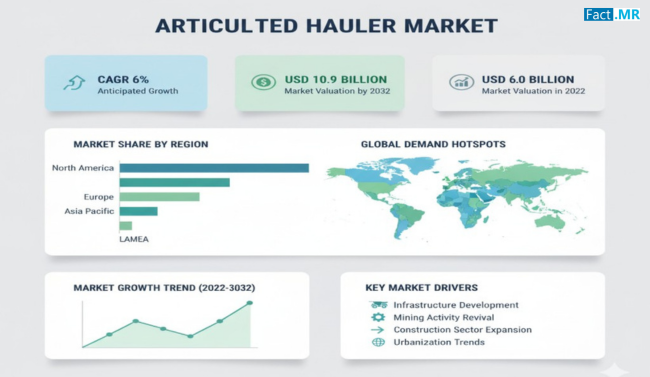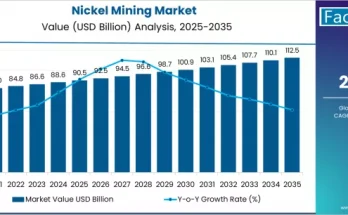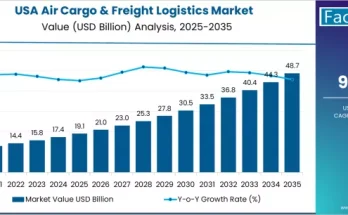Articulated haulers, also known as articulated dump trucks, are pivotal in modern construction, mining, and infrastructure projects. Designed to transport heavy loads across challenging terrains, these vehicles provide flexibility, durability, and superior maneuverability. As urbanization accelerates and large-scale infrastructure projects expand globally, articulated haulers have become an indispensable component of heavy machinery fleets, enhancing efficiency and reducing project timelines.
Market Overview:
The articulated hauler market covers a wide range of payload capacities and engine powers, catering to diverse industrial needs. These vehicles feature a jointed chassis, allowing the front and rear sections to move independently, which ensures stability and traction on uneven terrain. Manufacturers offer various models with different payload ranges and engine configurations to meet the demands of construction, mining, and utility sectors.
Articulated haulers are preferred over rigid trucks in areas with rough terrains, steep slopes, or tight turning spaces. Their ability to carry large volumes of material efficiently makes them essential in transporting soil, rocks, minerals, and other bulk materials. Additionally, technological advancements, such as enhanced engine control, fuel efficiency, and driver assistance systems, have improved the performance and safety of these vehicles.
Regional Insights:
East Asia, including China and Japan, represents a significant portion of the articulated hauler market, driven by rapid industrialization, infrastructure development, and growing mining operations. North America, particularly the United States, also holds a substantial market share due to ongoing construction projects and modernization of urban infrastructure. Europe’s demand is fueled by extensive infrastructure projects, including high-speed rail and urban redevelopment initiatives, with countries like Germany, the UK, and France leading adoption.
South Asia and Oceania are emerging markets, with increasing investments in road, dam, and railway projects. The growing industrial and utility sectors in countries like India and Australia are expected to drive the demand for articulated haulers in the coming years.
Key Trends and Forecast:
The articulated hauler market is experiencing several significant trends:
- Increased Infrastructure Projects:Rising investments in highways, dams, railways, and urban redevelopment projects are driving demand for efficient heavy transport solutions.
- Technological Advancements:Manufacturers are integrating features such as superior engine performance, fuel efficiency, advanced suspension systems, and enhanced safety mechanisms.
- Equipment Rental Growth:With rising costs of machinery and economic uncertainty, rental services for articulated haulers are becoming more popular, enabling temporary solutions for construction and mining projects.
- Diversification of Applications:Beyond construction and mining, articulated haulers are increasingly used in industrial, utility, and automotive sectors, reflecting the versatility of these vehicles.
Applications and End-Use Outlook:
Articulated haulers are primarily employed in sectors requiring heavy material transport over challenging terrains:
- Construction Industry:Used in large-scale building projects, road construction, and urban redevelopment, articulated haulers ensure timely material movement while reducing labor and operational costs.
- Mining Sector:The ability to transport bulk materials over rough terrains makes these vehicles indispensable for mining operations, including coal, metal ores, and minerals.
- Industrial and Utility Projects:Haulers assist in moving construction materials for power plants, refineries, and industrial complexes, ensuring smooth project execution.
- Automotive Industry Applications:Large infrastructure projects supporting automotive manufacturing, such as plant expansions and road networks, increasingly rely on articulated haulers for efficient material transport.
Challenges and Market Restraints:
While articulated haulers offer numerous advantages, the market faces challenges. High initial investment costs and maintenance expenses may limit adoption, particularly among small and medium enterprises. Additionally, integrating these vehicles into existing fleet operations requires trained operators and specialized infrastructure. Regulatory compliance, including environmental and emission standards, also adds to operational complexity, necessitating the development of cleaner, more efficient machinery.
Country-wise Analysis:
The United States dominates the North American market, contributing to a large share of regional sales due to ongoing infrastructure upgrades and construction activities. China leads East Asia, supported by rapid urbanization and mining expansion, while Japan remains a key market for technologically advanced haulers. Europe’s growth is driven by countries like the UK and France, with major projects including high-speed rail and urban redevelopment initiatives. In South Asia and Oceania, increasing construction and mining activities are expected to fuel growth, with India and Australia at the forefront.
Conclusion:
The articulated hauler market is poised for steady growth, driven by infrastructure development, mining expansion, and industrial projects worldwide. With technological innovations, increasing equipment rental adoption, and diversification into industrial and automotive applications, articulated haulers are redefining heavy transport efficiency. Investing in advanced articulated hauler solutions enables companies to enhance operational productivity, reduce costs, and meet the growing demands of construction and mining sectors. As global infrastructure and industrialization efforts continue, articulated haulers will remain a cornerstone of modern heavy machinery fleets.



